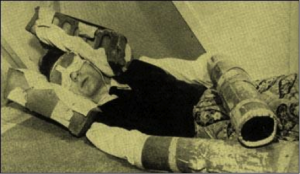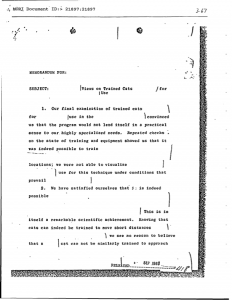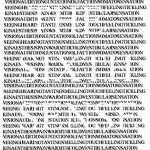Acoustic Kitty
The CIA and Sensory Experimentation
This document is a redacted CIA memo from 1967 describing one of the many experiments devised amidst American cold war paranoia to spy and gain intelligence on the Soviets. The idea behind the experiment, code-named “Acoustic Kitty,” was to develop an audio device that could function and record conversations in public. At the time, the CIA had been testing methods of audio surveillance by inserting miniature microphones (developed by hearing aid manufacturers) into bullets strong enough to withstand the force of a gunshot and still keep recording. These tests yielded smaller, rugged microphones, but no “spy-bullet,” since microphones would pick up all sounds, relevant or not, making most recordings largely useless.
According to former CIA officer Victor Marchetti, cats were selected because, like humans, their cochlear anatomy allows them to filter and focus sound. Interviewed in 1995 by BBC journalist Adam Curtis, Marchetti recalls, “The cat that was used for the experiments had to be cut open and have a power pack placed inside its abdomen, wires were run up to its ears, to its cochlea, its tail was used as an antenna, wires were hooked to its brain to determine when it was hungry or sexually aroused, and wires to override these urges” so the cat wouldn’t walk off the job. Former CIA technical officer Robert Wallace notes, “the implant could not affect any of the natural movements of the cat, nor could the cat experience any sense of irritation or the presence of the device, lest it induce rubbing or clawing to dislodge components or disturb performance.” (200) Nevertheless, in an era before PETA, this experiment and others like it (including some experiments on humans) were unregulated.
They then trained the cat to listen specifically to human conversations, and after many trials, the cat was sent on its first mission. In a van loaded with equipment, they drove the cat to a location and sent it across the street to spy on Soviet agents sitting in a park. Marchetti, a prominent critic of the CIA, recalls, “as this poor little monstrosity waddled across the street, a taxicab came around and ran it over, 25 million dollars down the drain.”
The memo above, declassified in 2001, is heavily redacted by US government censors. Available through the National Security Archive, a non-profit group defending public access to government information in the US, the document speaks even when much of the text is out of sight. Despite the Freedom of Information Act, there are security exemptions under which information can be protected and removed from sight. Commentators say this “cover up” might imply the CIA was embarrassed to disclose all the details of the project. While the memo seems to acknowledge the technical viability of training cats for surveillance purposes, ultimately it concludes the idea isn’t “practical.” According to Robert Wallace, “the cat wanted to do what the cat wanted to do, and not what we wanted it to do.” (202)
It’s an irony throughout history that many unspeakable acts are documented with pathological detail. The unseen represents a silencing of truths, while at the same time, the memo itself aims to report facts and — more than this — display pride for the “energy and imagination” of a job well done. Futurologist Stewart Brand is known for saying “Information Wants To Be Free. Information also wants to be expensive… That tension will not go away.” Such heavily redacted documents signal a time when the flow of information has trickled to a halt—a foreclosure of this freedom.
The CIA’s experiments on humans were likewise uncontrolled, and Canada was complicit in this research. In 1952, at McGill University in Montreal, Dr. Ewen Cameron and his colleague Dr. Donald Hebb, conducted experiments involving shock treatments, psychotic drugs, mind control and sensory deprivation which, according to Naomi Klein in her book The Shock Doctrine, assisted the CIA in creating a handbook on interrogation techniques, paving the way for later torture techniques used at Abu Ghraib and Guantanamo Bay. This image below, from the McGill University Archives, depicts one of Dr. Hebb’s sensory deprivation subjects; with just a few simple tools such as goggles, gloves and pillows, subjects could be reduced to a state of psychosis. The sinister tenor of this era of espionage fueled the cultural imagination, as seen in film and literary works such as The Manchurian Candidate, La Jetée and The Conversation.
—Dana Samuel
PhD Humanities Student
Concordia University
References
Boychuk, Regan. “Torture: A History of Hypocracy.” The Literary Review of Canada. May 2008. 5-7. Print.
A History of Hypocrisy
Curtis, Adam. The Living Dead: Three Films about the Power of the Past. London: BBC 2, 1995. Video.
Adam Curtis: The Living Dead
Edwardes, Charlotte. “CIA recruited cat to bug Russians.” The Telegraph. November 4, 2001. Web.
A Recruited Cat to Bug Russians
Klein, Naomi. The Shock Doctrine: The Rise of Disaster Capitalism. Toronto: Knopf Canada. 2007. Print.
Richelson, Jeffrey, ed. “Science Technology and the CIA: A National Security Archive Electronic Briefing Book.” National Security Archive, September 10, 2001. Web.
Science, Technology and the CIA
Richelson, Jeffrey. The Wizards of Langley: Inside the CIA’s Directorate of Science and Technology. Boulder, Colorado: Westview Press, 2001. 146-159. Print.
Rothman, Wilson. “CIA Animal Tech: Bats, Cats and Rats as Covert Operatives.” Gizmodo, May 22, 2008. Web.
CIA Animal Tech Bats, Cats and Rats as Covert Operatives
Squire, Eric. “Beyond the academic facade: A Virtual Tour of Old McGill.” January, 2011. Web.Beyond the Academic Facade: A Virtual Tour of Old McGill
Wallace, Robert, H. Keith Melton and Henry R. Schlesinger. Spycraft: The Secret History of the CIA’s Spytechs from Communism to Al Quaeda. New York: Dutton, 2008. 200-202. Print.



